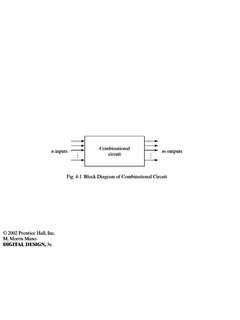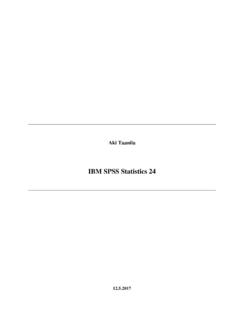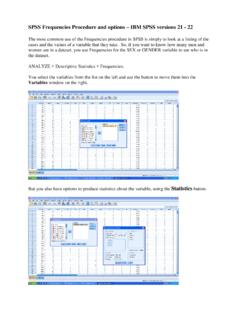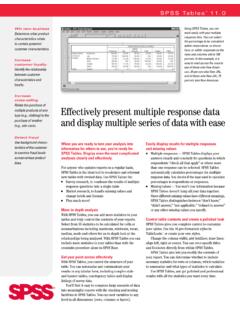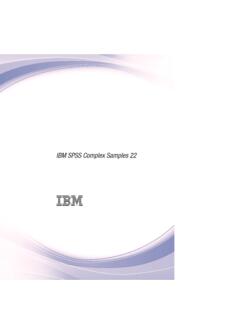Transcription of An Introduction to the WEKA Data Mining System
1 An Introduction to the WEKA data Mining SystemZdravko Markov Central Connecticut State Russell University of Mining "Drowning in data yet Starving for Knowledge" ??? "Computers have promised us a fountain of wisdom but delivered a flood of data "William J. Frawley, Gregory Piatetsky-Shapiro, and Christopher J. Matheus data Mining : "The non trivial extraction of implicit, previously unknown, and potentiallyuseful information from data "William J Frawley, Gregory Piatetsky-Shapiro and Christopher J Matheus data Mining finds valuable information hidden in large volumes of data . data Mining is the analysis of data and the use of software techniques for finding patterns and regularities in sets of data .
2 data Mining is an interdisciplinary field involving: Databases Statistics Machine Learning High Performance Computing Visualization Mathematics KDnuggets: Polls: data Mining Tools You Used in 2005 (May 2005) PollData Mining /Analytic tools you used in 2005 [376 voters, 860 votes total] Enterprise-level: (US $10,000 and more)Fair Isaac, IBM, Insightful, KXEN, Oracle, SAS, and SPSS Department-level: (from $1,000 to $9,999)Angoss, CART/MARS/TreeNet/Random Forests, Equbits, GhostMiner, Gornik, Mineset, MATLAB, Megaputer, Microsoft SQL Server, Statsoft Statistica, ThinkAnalytics Personal-level: (from $1 to $999): Excel, See5 Free: , R, Weka, Xelopes data Mining SoftwareKDnuggets : News : 2005 : n13 : item2 SIGKDD Service Awardis the highest service award in the field of data Mining and knowledge discovery.
3 It is is given to one individual or one group who has performed significant service to the data Mining and knowledge discovery field, including professional volunteer services in disseminating technical information to the field, education, and research 2005 ACM SIGKDD Service Awardis presented to the Weka teamfor their development of the freely-available Weka data Mining Software, including the accompanying book data Mining : Practical Machine Learning Tools and Techniques (now in second edition) and much other documentation. The Weka team includes Ian H. Wittenand Eibe Frank, and the following major contributors (in alphabetical order oflast names): Remco R. Bouckaert, John G. Cleary, Sally Jo Cunningham, Andrew Donkin, Dale Fletcher, Steve Garner, Mark A.
4 Hall, Geoffrey Holmes, Matt Humphrey, Lyn Hunt, Stuart Inglis, Ashraf M. Kibriya, Richard Kirkby, Brent Martin, Bob McQueen, Craig G. Nevill-Manning, Bernhard Pfahringer, Peter Reutemann, Gabi Schmidberger, Lloyd A. Smith, Tony C. Smith, Kai Ming Ting, Leonard E. Trigg, Yong Wang, Malcolm Ware, and Xin Xu. The Weka team has put a tremendous amount of effort into continuously developing and maintaining the System since 1994. The development of Weka was funded by a grant from the New Zealand Government's Foundation for Research, Science and Technology. The key featuresresponsible for Weka's success are: it provides many different algorithms for data Mining and machine learning is is open source and freely available it is platform-independent it is easily useable by people who are not data Mining specialists it provides flexible facilities for scripting experiments it has kept up-to-date, with new algorithms being added as they appear in the research literature.
5 Weka data Mining SoftwareWeka data Mining SoftwareKDnuggets : News : 2005 : n13 : item2 (cont.)The Weka data Mining Software has been downloaded 200,000 timessince it was put on SourceForge in April 2000, and is currently downloaded at a rate of 10,000/month. The Weka mailing list has over 1100 subscribers in 50 countries, including subscribers from many major companies. There are 15 well-documented substantial projectsthat incorporate, wrap or extend Weka, and no doubt many more that have not been reported on Sourceforge. Ian H. Witten and Eibe Frank also wrote a very popular book " data Mining : Practical Machine Learning Tools and Techniques"(now in the second edition), that seamlessly integrates Weka System into teaching of data Mining and machine learning.
6 In addition, they provided excellent teaching materialon the book website. This book became one of the most popular textbooks for data Mining and machine learning, and is very frequently cited in scientific publications. Weka is a landmark System in the history of the data Mining and machine learningresearch communities, because it is the only toolkit that has gained such widespread adoption and survived for an extended period of time (the first version of Weka was released 11 years ago). Other data Mining and machine learning systems that have achieved this are individual systems, such as , not toolkits. Since Weka is freely available for download and offers many powerful features (sometimes not found in commercial data Mining software), it has become one of the most widely used data Mining systems.
7 Weka also became one of the favorite vehicles for data Mining research and helped to advance it by making many powerful features available to all. In sum, the Weka team has made an outstanding contribution to the data Mining field. Using Weka to teach Machine Learning, data and Web Learning, data and Web Miningby Example( learning by doing approach) data preprocessing and visualization Attribute selection Classification (OneR, Decision trees) Prediction (Nearest neighbor) Model evaluation Clustering (K-means, Cobweb) Association rulesData preprocessing and visualizationInitial data Preparation(Weka data input) Raw data (Japanese loan data ) Web/Text documents (Department data ) data preprocessing and visualizationJapanese loan data (a sample from a loan history database of a Japanese bank)Clients:s1.
8 , s20 Approved loan: s1, s2, s4, s5, s6, s7, s8, s9, s14, s15, s17, s18, s19 Rejected loan: s3, s10, s11, s12, s13, s16, s20 Clients data : unemployed clients: s3, s10, s12 loan is to buy a personal computer: s1, s2, s3, s4, s5, s6, s7, s8, s9, s10 loan is to buy a car: s11, s12, s13, s14, s15, s16, s17, s18, s19, s20 male clients: s6, s7, s8, s9, s10, s16, s17, s18, s19, s20 not married: s1, s2, s5, s6, s7, s11, s13, s14, s16, s18 live in problematic area: s3, s5 age: s1=18, s2=20, s3=25, s4=40, s5=50, s6=18, s7=22, s8=28, s9=40, s10=50, s11=18, s12=20, s13=25, s14=38, s15=50, s16=19, s17=21, s18=25, s19=38, s20=50 money in a bank (x10000 yen): s1=20, s2=10, s3=5, s4=5, s5=5, s6=10, s7=10, s8=15, s9=20, s10=5, s11=50, s12=50, s13=50, s14=150, s15=50, s16=50, s17=150, s18=150, s19=100, s20=50 monthly pay (x10000 yen): s1=2, s2=2, s3=4, s4=7, s5=4, s6=5, s7=3, s8=4, s9=2, s10=4, s11=8,s12=10, s13=5, s14=10, s15=15, s16=7, s17=3, s18=10, s19=10, s20=10 months for the loan: s1=15, s2=20, s3=12, s4=12, s5=12, s6=8, s7=8, s8=10, s9=20, s10=12, s11=20, s12=20, s13=20, s14=20, s15=20, s16=20, s17=20, s18=20, s19=20, s20=30 years with the last employer.
9 S1=1, s2=2, s3=0, s4=2, s5=25, s6=1, s7=4, s8=5, s9=15, s10=0, s11=1, s12=2, s13=5, s14=15, s15=8, s16=2, s17=3, s18=2, s19=15, s20=2 data preprocessing and visualizationLoan data CVS format( )Relations, attributes, tuples (instances) data preprocessing and visualizationAttribute-Relation File Format (ARFF) - ~ml/ preprocessing and visualizationDownload and install Weka - ~ml/weka/ data preprocessing and visualizationRun Weka and select the ExplorerData preprocessing and visualizationLoad data into Weka ARFF format or CVS format (click on Open ) data preprocessing and visualizationConverting data formats through Weka (click on ) data preprocessing and visualizationEditing data in Weka (click on ) data preprocessing and visualizationExamining data Attribute type and properties Class (last attribute) distributionData preprocessing and visualizationClick on Visualize All data preprocessing and visualizationWeb/Text documents - Department ~markov/ Download Ch1, DMW Book Download datasetsData preprocessing and visualizationConvert HTML to TextData preprocessing and visualizationLoading text data in Weka String format for ID and content One document per line Add class (nominal)
10 If neededData preprocessing and visualizationConverting a string attribute into nominalChoose filters/unsupervised/attribute/StringToN ominaland and set the index to 1 data preprocessing and visualizationConverting a string attribute into nominalClick on Apply document_name is now nominalData preprocessing and visualizationConverting text data into TFIDF (Term Frequency Inverted Document Frequency) attribute format Choose filters/unsupervised/attribute/StringToW ordVector Set the parameters as needed (see More ) Click on Apply data preprocessing and visualizationMake the class attribute last Choose filters/unsupervised/attribute/Copy Set the index to 2 and click on Apply Remove attribute 2 data preprocessing and visualization Change the attributes to nominal (use NumericToBinary filter) Save data on a file for further useData preprocessing and visualizationARFF file representing the department data in binary format (NonSparse)Note the format (see SparseToNonSparseinstance filter)Attribute SelectionFinding a minimal set of attributes that preserve the class distributionIF accounting=1 THEN class=A (Error=0, Coverage = 1 instance overfitting)
